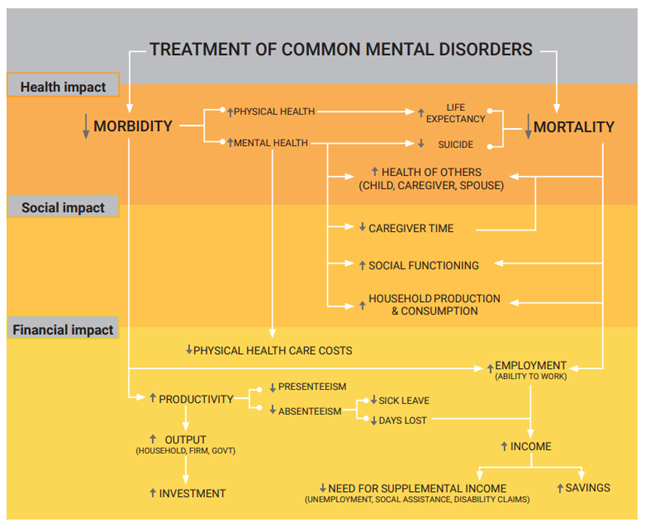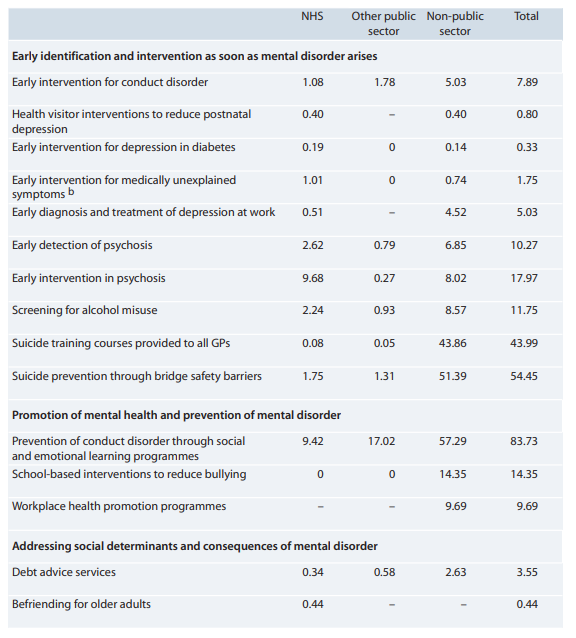Funding and Economics
For the past five years, per head spend on across all mental health services (adjusted for mental health need) has been below the national average in Cambridgeshire and Peterborough. These figures include spending on all-age mental health services, as well as learning disability and dementia services.
Figure 28: Per head spending on mental health services in Cambridgeshire and Peterborough, adjusted for mental health need. Data source: Royal College of Psychiatrists. Note: this data is standardised to take account of mental health need using NHS England needs-based population data for 2018/19 – 2021/22.
Getting It Right First Time (GIRFT) recommends that trusts work with system partners to ensure that the Mental Health Investment Standard is met, and that they have nominated finance/transformation leads at senior level with a thorough understanding of the Standard and can specifically identify the growth in investment expected in each service area (Davidson, 2021)
Health economics
- Although health economics is used to inform decision making across healthcare systems, this has historically been underused within mental health (Lathe et al., 2023).
- Some argue that economic estimates of the impact of mental health conditions often underestimates their true costs. Mental ill health may have a range of impacts on society, including on interpersonal relationships, education, employment and benefits, social services, other areas of the healthcare system and the criminal justice system (Lathe et al., 2023; Watson, n.d.).
- In a 2023 review of mental health services in England, the National Audit Office highlighted that ‘understanding of costs of services is still poor for many areas, including in primary and community services’ (House of Commons Committee of Public Accounts, 2023).
The World Health Organisation has proposed that frameworks analysing the impacts of investing in mental health services should consider health impacts (e.g. on both physical and mental health), social impacts (e.g. on social functioning and carers) and financial impacts (e.g. on employment and physical health care costs) (World Health Organisation, 2021). However, the scope of analyses and the availability of data varies across these domains.
Figure 29: Analytical framework for identifying potential impacts of mental health investment. Image source: World Health Organisation
Cost of mental illness
- Mental health is an ‘indispensable part of health’ (World Health Organisation, 2021), with poor mental health impacting individual’s quality of life and life span.
- It has been estimated that mental health problems cost the UK economy at least £118 billion each year, appropriately 5% of the UK GDP in 2019 (McDaid et al., 2022). The majority of these costs are due to the lost productivity of people with mental illnesses and costs incurred by unpaid carers (McDaid et al., 2022).
- This figure is likely to be underestimate as it does not include impacts of presenteeism or absenteeism in the workplace, or the links with physical health conditions (McDaid et al., 2022).
- Comparatively, the NHS spent £16.8 billion on mental health services in 2023/23, including spend on learning disability, autism and dementia services (NHS England, 2023e).
- Mental illness has a substantial impact on the national workforce: mental illness is consistently one of the top five reasons for sickness absence in the UK (Office for National Statistics, 2023) and ‘presenteeism’ due to mental ill-health (in which people still attend work but are less productive) is estimated to account for 1.5 times as much working time lost to absenteeism and to have a significant cost to employers (The Sainsbury Centre for Mental Health, 2007).
- There are close links between poor mental health and physical health conditions, with co-morbid mental health conditions raising total health care costs by an estimated 45% for each person with a long-term physical health condition. It has been estimated that between 12 to 18% of NHS spending on long-term conditions is linked to poor mental health and wellbeing (Naylor et al., 2012).
- The 2010 Marmot review highlighted that health inequalities directly cost the NHS at least £5.5 billion per year. Productivity losses associated with inequalities are thought to be between £31 to £33 billion per year (Marmot, 2010).
Economic case for prevention
The Mental Health Foundation carried out a rapid review of cost-effective interventions to prevent the development of mental health conditions, drawing on systematic reviews as well as individual studies published between 2019 and 2021. This review identified a range of research highlighting the economic benefits of prevention, although the majority of these interventions were aimed at children and young people.
Figure 30: Examples of interventions with a strong evidence base for preventing mental health conditions across the life course. Image source: Mental Health Foundation
Other useful resources include:
- Public Health England’s health economics evidence resource summaries economic evidence for public health interventions.
- The Health Financial Management Association report sets out the steps for NHS finance staff to make the case to address health inequalities
- Public Health England produced a guide for Commissioning Cost-Effective Services for Promotion of Mental Health and Wellbeing and Prevention of Mental Ill-Health
Cost-effectiveness of early intervention and treatment
A 2011 report estimated the savings associated with 15 types of mental health promotion and prevention programmes, looking at savings across the NHS, public sector and wider impacts, across the short, medium and long-term (Knapp et al., 2011). The table below highlights total savings across each of these sectors:
Figure 31: Total returns on investment (economic payoffs per £1 expenditure). Image source: Mental health promotion and mental illness prevention: The economic case
As highlighted above, there are significant short and longer-term economic benefits of early intervention in psychosis (EIP) services. The net cost savings per person after the first four years is £7,972, with a further £6,780 saving per person in the next four to 10 years if full EIP provisions are provided. Over a 10-year period this would result in £15 of costs saved for every £1 invested (Public Health England, 2019): The majority of these savings are due to:
- the reduction in use of crisis and inpatient services.
- improved employment outcomes.
- the reduction in risk of future hospitalisation as a result of improved management and reduced risk of relapse.
Financial opportunities
The GIRFT report has identified financial opportunities linked to MH crisis and acute services relating to:
- Improve community-based care and local inpatient capacity, to reduce out of area placements
- Ensure existing staff capacity is efficiently utilised and train sufficient numbers of professionally qualified staff, to reduce bank and agency costs
- Reduction in patients that present to Accident and Emergency 24 hours or less, prior to admission, to reduce Accident and Emergency attendances
- Reduce unexplained variation in admissions under the Mental Health Act, to reduce admissions under the Mental Health Act
- Most short-stay hospital cases could and should receive better care in the community, to reduce proportion of short stay hospital admissions (0-3 days length of stay)
- Ensure people do not become stranded in community teams or inpatient services, to reduce length of stay of patients staying over 60 days
The experience of people with lived experience and local staff may provide opportunities to better understand these areas for improvement.
Additional resources
- The economic and social costs of mental ill health
- Oxford Mental Health Economics and Policy
- Mental Health Investment Standard (MHIS) categories
- The economic case for investing in the prevention of mental health conditions in the UK
- Mental health promotion and mental illness prevention: The economic case
- Better Mental Health For All
- Mental health investment case: a guidance note
- Public mental health: Evidence, practice and commissioning (see pages 109 – 114)
- The Economic and Social Costs of Mental Ill Health
References
Full list of references is included at the end of this chapter.




